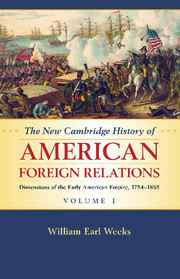Overviews of antebellum American foreign relations include
Max Savelle, The Origins of American Diplomacy: The International History of Anglo-America, 1492–1763 (New York, 1967), a still-valuable comprehensive survey.
Bradford Perkins, The Creation of a Republican Empire, 1776–1865 (Cambridge, 1993), offers a useful framework for conceptualizing antebellum American foreign relations.
Walter LaFeber, The American Age: U.S. Foreign Policy at Home and Abroad 1750 to the Present (New York, 1994), traces the expansionist roots of American foreign relations.
John Lewis Gaddis, Surprise, Security, and the American Experience (Cambridge, 2004), argues that contemporary American foreign policy actions are rooted in antebellum precedents.
Robert Kagan, Dangerous Nation: America’s Place in the World from Its Earliest Days to the Dawn of the Twentieth Century (New York, 2006), is a provocative work that connects the nation’s pugnacious expansionism with the spread of liberal capitalism.
George C. Herring, From Colony to Superpower: U.S. Foreign Relations Since 1776 (New York, 2008), is a comprehensive survey by an esteemed scholar.
D. W. Meinig’s The Shaping of America: A Geographical Perspective on 500 Years of History, volume 2, Continental America, 1800–1867(New Haven, 1993), is, along with the other three volumes, a landmark achievement of multidisciplinary scholarly research and historical insight. It is an indispensable tool for understanding the geographic basis of the American Empire.
James D. Drake, The Nation’s Nature: How Continental Presumptions Gave Rise to the United States of America (Charlottesville, 2011), also emphasizes the importance of geography in the conception of the American Empire.
William Appleman Williams and Richard W. Van Alstyne provide starting points for the study of the antebellum American Empire. See
Williams, The Contours of American History (Cleveland, 1961); and
Van Alstyne, The Rising American Empire (New York, 1974; first published 1960);
Empire and Independence: The International History of the American Revolution (New York, 1965); and
Genesis of American Nationalism (Waltham, Mass., 1970).
Major Wilson, Space, Time, and Freedom: The Quest for Nationality and the Irrepressible Conflict, 1815–1861 (Westport, Conn., 1974), remains a conceptually valuable contribution.
Books dealing with the topic of empire more generally include
Michael W. Doyle, Empires (Ithaca, 1986), a perceptive comparative study, and
Paul Kennedy, The Rise and Fall of the Great Powers: Economic Change and Military Conflict from 1500 to 2000 (New York, 1987), which situates the U.S. experience amid the Age of Europe.
Marc Engal, A Mighty Empire: The Origins of the American Revolution (Ithaca, 1988), provides a detailed account of the expansionist factions in each colony in the years before the revolution.
Andrew Bacevich, ed., The Imperial Tense: Prospects and Problems of American Empire (Chicago, 2003), contains a range of ideological perspectives on the topic.
Craig Calhoun, Frederick Cooper, and in Kevin W. Moore, eds., Lessons of Empire: Imperial Histories and American Power (New York, 2006), a distinguished group of scholars assesses American empire from a comparative framework.
Charles S. Maier, Among Empires: American Ascendancy and Its Predecessors (Cambridge, Mass., 2006), is a sophisticated study by a senior scholar.
David Armitage, The Ideological Origins of the British Empire (Cambridge, 2000), links U.S. imperial ideology and action to that of Great Britain.
Michael Hardt and Antonio Negri, Empire (Cambridge, 2000), an important theoretical approach to empire;
Amy Kaplan, The Anarchy of Empire in the Making of U.S. Culture (Cambridge, 2002), emphasizes the centrifugal aspect of imperial conquests;
Niall Ferguson, Colossus: The Price of America’s Empire (New York, 2004), is vigorously argued if at times problematic in its assumptions and conclusions.
Ann Stoler, ed., Haunted by Empire: Geographies of Intimacies in North American History (Durham, N.C., 2006), offers a postcolonial view of American Empire.
Eric Hobsbawm, On Empire: America, War, and Global Supremacy (New York, 2008), features four short essays by a leading British historian.
Richard Immerman, Empire for Liberty (Princeton, 2010), traces the history of the American Empire through biographical sketches of six of its key architects.
Eliga Gould, Among the Powers of the Earth: The American Revolution and the Making of a New World Empire (Cambridge, Mass, 2012), situates the rise of the United States as a part of the European imperial struggle for North America.
The American Empire cannot be understood apart from the creation of an American nationalism. Books on that topic include
Ernest L. Tuveson, Redeemer Nation: The Idea of America’s Millennial Role (Chicago, 1968), which traces the origins of redeemer nation ideology, and
Conrad Cherry, ed., God’s New Israel: Religious Interpretations of American Destiny, revised and updated edition (Chapel Hill, 1998; first published, 1971).
Carolyn Marvin and David W. Ingle, Blood Sacrifice and the Nation: Totem Rituals and the American Flag (New York, 1999), offers a sophisticated analysis of war and patriotism as key bonding agents in the creation of American nationalism.
Thomas Bender, ed., Rethinking American History in a Global Age (Los Angeles, 2002), is a collection of essays by a diverse group of scholars that places U.S. history in a global context.
James A. Morone, Hellfire Nation: The Politics of Sin in American History (New Haven, 2003), emphasizes the role of Christianity in the creation of American nationalism.
Thomas Bender, A Nation Among Nations: America’s Place in World History (New York, 2006), is an insightful discussion by a leading authority on American nationalism; and
Carroll Smith-Rosenberg, This Violent Empire: The Birth of an American National Identity (Chapel Hill, 2010), details the role of violence as a cultural bonding agent.
There is a growing literature that views U.S. continental expansion from a Native American perspective. It includes
Richard Drinnon, Facing West: The Metaphysics of Indian-Hating and Empire-Building (Minneapolis, 1980);
Stuart Banner, How the Indians Lost Their Land (Cambridge, Mass., 2003); and
Paul Van der Velder, Savages and Scoundrels: The Untold Story of the American Road to Empire Through Indian Territory (New Haven, 2009).



